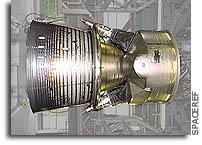Arianespace to Continue with Launches of the Baseline Ariane 5

Arianespace is developing its return-to-flight plan for Ariane 5 after receiving an independent inquiry board’s findings on the anomaly encountered during Flight 157 in December.
At a press briefing in Paris today, Arianespace Chief Executive Officer Jean-Yves Le Gall said the next Ariane 5 mission is targeted for February 24 using a baseline Ariane 5 version, while the increased-performance Ariane 5 ECA could fly again in six months.
The inquiry board’s investigation of the December 11 anomaly pinpointed the problem in the Vulcain 2 cryogenic main engine’s exhaust nozzle cooling system.
In submitting its report to Arianespace yesterday, the board said leaks in the nozzle’s cooling tubes occurred early in the flight. This lead to overheating of the Vulcain 2’s nozzle – resulting in dissymmetric thrust, which caused a loss of flight control and the forced termination of Ariane 5 ECA’s maiden mission.
The Vulcain 2 engine on Ariane 5 ECA is more powerful and has a larger nozzle than the Vulcain 1 that powers the Ariane 5 Baseline vehicle. During flight, the Vulcain 2’s larger nozzle is subject to increased flight loads that cannot be simulated during ground test firings.
Wolfgang Koschel, who chaired the inquiry board into the Flight 157 anomaly, said small fissures that occurred in the Vulcain 2 nozzle’s tubes were the result of mechanical and thermal loads experienced during the December 11 mission.
The board made three recommendations for actions, which have been accepted by Arianespace:
- Modify the nozzle on future Vulcain 2 engines, taking into account the experience learned from the 12 successful flights of Vulcain 1s flown on Ariane 5 Baseline launchers,
- Research the possibilities of ground test simulations of the flight loads that were observed on the Vulcain 2 nozzle during Flight 157, and
- Reinforce the quality of flight hardware, and in particular, establish acceptance procedures that are even stricter.
Arianespace’s Le Gall commended the inquiry board for its “extraordinary work performed almost day and night” since the group was formed on December 13 to investigate the Flight 157 failure. “I thank the board for all of its efforts, and for the extremely precise determination of the anomaly’s origins,” Le Gall told reporters.
Le Gall said Arianespace continues to move ahead with its launch activity. The final flight of an Ariane 4 is scheduled for liftoff on February 12, while a mission using an Ariane 5 Baseline launcher is set for February 24.
“We are extremely confident about the flightworthiness of the Ariane 5 Baseline launcher with its Vulcain 1 engine, and our confidence is being borne out by re-verifications of the nozzle behavior that currently are underway,” he explained. “For the Ariane 5 ECA, we currently are working on a recovery plan that should be ready for presentation on January 20.”
Le Gall said the goal of conducting the next flight of an Ariane 5 ECA in approximately six months is “very ambitious, but extremely realistic.”
He said the Arianespace continues to plan on using the Ariane 5 ECA as the company’s workhorse launch vehicle, gaining significant mission flexibility due to its 10 metric ton payload lift capability to geostationary transfer orbit (GTO). “Ariane 5 ECA will allow Arianespace to pair up almost any combination of telecommunications satellite payloads on missions to GTO, which is a competitive plus,” Le Gall explained.
While Arianespace would have preferred a successful introduction of the Ariane 5 ECA on its maiden flight last December, the company is not penalized because the weight of satellites have not grown as quickly as originally anticipated. “In reality, we were ahead of the market, and therefore the Ariane 5 Baseline will serve our mission needs very well until the Ariane 5 ECA is able to enter service,” he added.
Le Gall noted that Arianespace has a strong backlog of 41 satellites to be launched. In the hours and days that followed the Flight 157 anomaly, the company has received messages of support from its international customer base, he said.
One launch decision that remains to be made concerns an upcoming flight of the European Space Agency’s Rosetta comet-chasing spacecraft. Although this mission is to use an Ariane 5 Baseline vehicle, the flight is special because of its unusual trajectory involving a planned delayed ignition of the upper stage. The special procedure is required by Rosetta’s interplanetary flight path, which will take it on a 10-year mission to intercept and study Comet Wirtanen.
“Because of the particular nature of this mission, we are taking a thorough look at the flight,” Le Gall said. “We should be ready to make a launch decision by January 14.”








